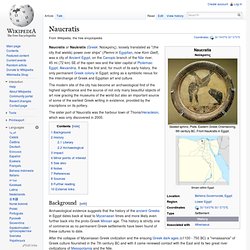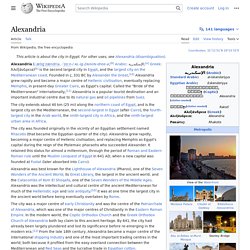Zoom
Trash

Naucratis. Naucratis or Naukratis (Greek: Ναύκρατις), loosely translated as "(the city that wields) power over ships" (Piemro in Egyptian, now Kom Gieif), was a city of Ancient Egypt, on the Canopic branch of the Nile river, 45 mi (72 km) SE of the open sea and the later capital of Ptolemaic Egypt, Alexandria.

It was the first and, for much of its early history, the only permanent Greek colony in Egypt; acting as a symbiotic nexus for the interchange of Greek and Egyptian art and culture. The modern site of the city has become an archaeological find of the highest significance and the source of not only many beautiful objects of art now gracing the museums of the world but also an important source of some of the earliest Greek writing in existence, provided by the inscriptions on its pottery. The sister port of Naucratis was the harbour town of Thonis/Heracleion, which was only discovered in 2000.
Background[edit] Map indicating location of Naucratis. Dinocrates. Dinocrates of Rhodes (also Deinocrates, Dimocrates, Cheirocrates and Stasicrates;[1] Greek: Δεινοκράτης ο Ρόδιος, fl. last quarter of the 4th century BC) was a Greek architect and technical adviser for Alexander the Great.

He is known for his plan for the city of Alexandria, the monumental funeral pyre for Hephaestion and the reconstruction of the Temple of Artemis at Ephesus, as well as other works. City Proposal of Mount Athos[edit] Prior to the building of Alexandria, when Alexander was looking to build a city in his glory, Dinocrates proposed to build a city on Mount Athos in Greece.[2] Alexander dropped the proposal as Dinocrates reportedly did not consider the living conditions of the residents when he admitted to not planning for grain to be grown near the city, instead, it was to be transported by sea.[3] The site of the current Alexandria was much more fertile and open than the harsh terrain of Mount Athos.
Lighthouse of Alexandria. The Lighthouse of Alexandria, sometimes called the Pharos of Alexandria (in Ancient Greek, ὁ Φάρος τῆς Ἀλεξανδρείας), was a lofty tower built by the Ptolemaic Kingdom between 280 and 247 BC and between 393 and 450 ft (120 and 137 m) tall. It was one of the tallest man-made structures on Earth for many centuries, and was regarded as one of the Seven Wonders of the Ancient World. Badly damaged by three earthquakes between 956 and 1323, it then became an abandoned ruin. It was the third longest surviving ancient wonder (after the Mausoleum at Halicarnassus and the still extant Great Pyramid of Giza) until in 1480 the last of its remnant stones were used to build the Citadel of Qaitbay on the site.
In 1994, French archaeologists discovered some remains of the lighthouse on the floor of Alexandria's Eastern Harbour.[1] Origin[edit] Three-dimensional reconstruction based on a comprehensive 2006 study Construction[edit] Height and description[edit] El-Mursi Abul Abbas Mosque. Al-Mursi Abu'l-'Abbas Mosque in Alexandria Entrance of Al-Mursi Abu'l-'Abbas Mosque El-Mursi Abul-Abbas Mosque (Arabic: جامع المرسي أبو العباس) is a famous mosque in Alexandria, Egypt.

It is dedicated to the 13th century Alexandrine Sufi saint el-Mursi Abul Abbas whose tomb it contains. Alexandria. Residential neighborhood in Alexandria Skyline from Montaza Yachting club in Montaza Alexandria (اسكندرية, pronounced [eskendeˈrejjæ] in Egyptian Arabic)[see other names] is the second largest city and the second largest metropolitan area in Egypt after Greater Cairo by size and number of population of 4.5 million, extending about 32 km (20 mi) along the coast of the Mediterranean Sea in the north central part of the country.

It is also the largest city lying directly on the Mediterranean coast. Alexandria is Egypt's largest seaport, serving approximately 80% of Egypt's imports and exports. From the late 19th century, Alexandria became a major center of the international shipping industry and one of the most important trading centers in the world, both because it profited from the easy overland connection between the Mediterranean Sea and the Red Sea, and the lucrative trade in Egyptian cotton. Names[edit] History[edit] In 619, Alexandria fell to the Sassanid Persians. Geography[edit]